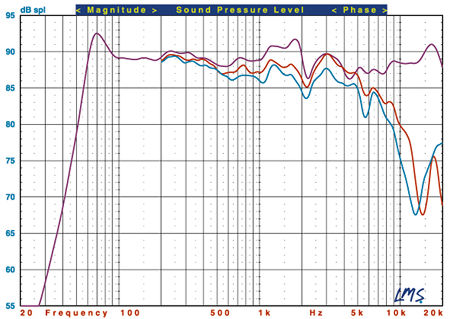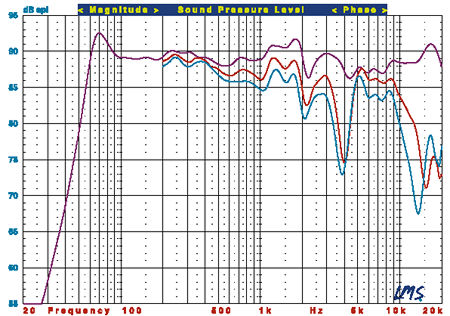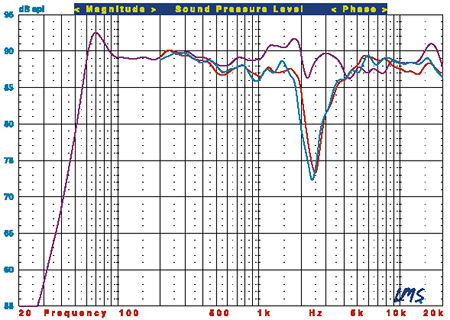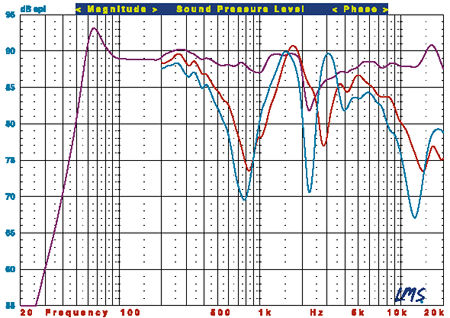Genesis 7.1c Speaker system Measurements
All measurements on the Genesis 7.1c were made with the grilles removed, the tweeter level control centered, and the rear tweeter turned off. The responses of both speakers with their grilles in place was a little less even in some regions of the mids and highs and a little more even in others; experimentation will determine which works best in your situation.
The impedance of the Genesis 7.1c dips to a minimum of 2.23 ohms at 65Hz, with another low point of 2.4 ohms at 3.3kHz. While the phase angle appears relatively benign, this is still a difficult load to drive. I would rate the speaker's nominal impedance at 4 ohms, but because of the minimum impedances I strongly recommend an amp that is comfortable with a load that drops to 2 ohms. As Steven notes in his review, this will eliminate most AV receivers from your shopping list. While Genesis has stated that the "Subwoofer" mode offers a higher impedance in the bass, our measurements showed a nearly identical minimum in both positions. The speaker's sensitivity is about 89dB/2.83V/m.
The G7.1c is designed to be used ether horizontally or vertically. In the vertical position the tweeter is located slightly off center. With the cabinet positioned vertically, the measurements in the horizontal plane on the tweeter axis are shown in Fig.1a.in the direction away from the tweeter (that is, toward the direction with the greatest spacing between the tweeter and the cabinet edge), and in Fig.1b toward the tweeter (the side with the tweeter closest to the cabinet edge). The on-axis averaged response is a pseudo-anechoic response averaged over a 30-degree forward horizontal angle, at tweeter height, combined with the nearfield responses of the woofers. The bass response shown is with the woofer control in the Normal position. This setting results in a sharp peak in the speaker's response at a relatively high 70Hz, with a rapid rolloff below that frequency. The With Sub position (not shown) produces a flatter response. The bass isn't particularly extended in either setting (-10dB at about 50Hz). The G7.1c is clearly designed to work best with a subwoofer.

Fig.1a: Genesis 7.1c, pseudo-anechoic response in the horizontal plane with the speaker vertically positioned, at 45-degrees (red) and 60-degrees (blue) off-axis, away from the tweeter.

Fig.1b: Genesis 7.1c, pseudo-anechoic response in the horizontal plane with the speaker vertically positioned, at 45-degrees (red) and 60-degrees (blue) off axis, toward the tweeter.
The on-axis average is a little bumpy, but still remains within relatively tight parameters.,and with in the specified +/-3dB across most of the frequency range. It shelves down slightly above 2kHz. As you move well off-axis toward the tweeter (Fig.1b), suckouts appear in the response at about 2.1kHz and 4kHz. In the opposite direction, however (away from the tweeter, Fig.1a) the response is smoother in these areas. This suggests that you should experiment with the tweeters positioned toward the middle or the outside; the orientation that sounds best will depend on factors as varied as the location of the sidewalls in your room and how much or how little you toe-in the speakers.
The overall +/-15 degree averaged front horizontal response of the G7.1c (Fig.2, with the speaker oriented placing the tweeter higher than the woofers) shows significant dips in the response at about 1.5kHz in both directions. You should sit as close as possible to the tweeter axis with this speaker.

Fig.2: Genesis 7.1c, pseudo-anechoic response with the speaker vertically positioned, taken at 15 degrees above (red) and 15-degrees below (blue) the tweeter.
Fig.3 shows the G7.1c's horizontal plane response with the cabinet oriented horizontally, as on top of a big-screen TV. The on-axis average is not as smooth as in the vertical orientation. This may be because the typical off-axis problems we encounter in a woofer-tweeter-woofer horizontal orientation begin at a modest 15-degree angle in the G7.1c, and Fig.3 is an average of the direct on-axis and plus and minus 15-degree off-axis responses. This horizontal configuration shows increasingly deep off-axis suckouts in the low midrange (cancellations from interference between the two woofers) and the low treble (interference between each woofer and the tweeter through the crossover region). While in our experience the audible effect of these suckouts is not as severe as they might appear from the curves (Steven was not troubled by them), they nonetheless suggest sitting as close as possible to direct axis of the speaker when it's oriented this way.

Fig.3: Genesis 7.1c, pseudo-anechoic response in the horizontal plane with the speaker horizontally positioned, at 45-degrees (red) and 60-degrees (blue) off-axis, away from the tweeter.
The vertical off-axis response of horizontally-positioned G7.1c will be the same as its horizontal response in the vertical—that is, the same as the responses in Figs.1a and 1b. Because of the speaker's asymmetrically-positioned tweeter, it will likely sound best when located above a television with the tweeter on top and at or above ear level.
The measured performance of the G7.1c isn't overly impressive, but nothing shown here was serious enough to temper Steven Stone's enthusiasm for the way the G7.1c system sounded.
All figures: Violet curve: pseudo-anechoic response on the tweeter axis, averaged across a 30-degree horizontal window, combined with nearfield woofer responses. All measurements taken at 1 meter.


























































